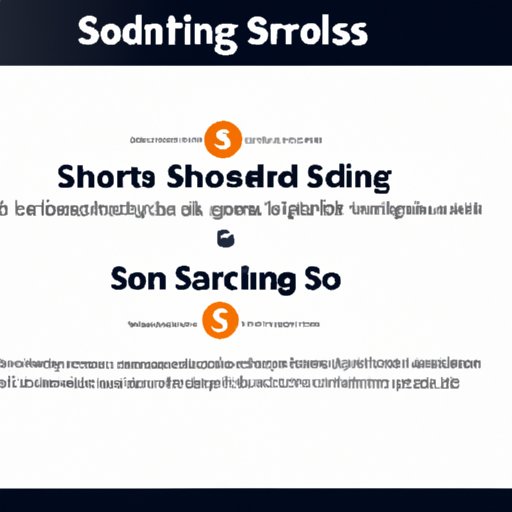
Exploring Short Selling: Strategies, Beginner’s Guide, Pros and Cons, Mechanics, and More
Short selling is a popular investment strategy that enables investors to profit from falling prices of stocks. While short selling can be complex and risky, it can also be an effective way to diversify your portfolio and earn a profit during extended market downturns. This article will explore the ins and outs of short selling, including strategies, beginner’s guide, pros and cons, mechanics, and ultimately, helping readers determine whether short selling is the right investment approach for them.
Top 5 Strategies for Shorting Stocks
Short selling is not a one-size-fits-all strategy, and investors can employ different techniques to short stocks. Here are some popular short selling strategies:
1. Short Selling Stocks
This is the traditional method of shorting stocks where you borrow shares of a particular stock, sell them, and repurchase them at a later time for a lower price. The difference between the selling price and the repurchasing price determines the profit or loss.
2. Puts Options
Put options provide a contractual right to sell a specific stock at a predetermined price within a defined period. The purchase of put options can be an excellent strategy for investors who want to short stocks without actually borrowing shares.
3. Inverse ETFs
An inverse ETF is designed to move in the opposite direction of a particular index. The fund aims to deliver returns that equal the inverse of the index’s daily returns. Investors buy short ETFs to hedge against market downturns or speculate on falling prices.
4. Synthetic Short Sale
A synthetic short sale involves simultaneously buying puts and selling calls on the same stock. This approach can be useful for investors looking for a more flexible and less risky short position.
5. Short Selling Exotic Assets
Exotic assets such as cryptocurrency, futures, and options can be shorted in a similar way to regular stocks. Shorting exotic assets can be a complex strategy that requires leverage, experience, and knowledge of the specific assets.
Beginner’s Guide to Shorting Stocks
Short selling can be intimidating, especially for beginner investors. Understanding the basics of short selling is a great place to start. Here’s a guide to help:
1. Identify Stocks to Short
The first step in short selling is identifying the stocks to sell short. A company with a weak balance sheet, declining sales, and poor management is usually a prime target. Having a list of desired stocks ready can help make the short selling process more manageable.
2. Using Technical Analysis to Determine Which Stocks to Short
Technical analysis is a tool that can help identify which stocks to short. Technical analysis helps to assess stock prices based on the historic price movements of a stock. Be sure when studying charts and using technical analysis, you complement existing knowledge with current news and events.
3. Risk Management for Short Selling
Short selling is a risky investment strategy that requires careful planning and execution. Ensuring that you manage risk properly is an essential aspect of short selling. Some common ways to manage risk include stop losses, regular loss limits, and strict adherence to a tested strategy.
Pros and Cons of Short Selling
Short selling can be an excellent way to diversify an investor’s portfolio and earn profits under certain market conditions. However, it also comes with some drawbacks. It’s important to weigh the pros and cons before engaging in short selling. Here’s an objective examination:
Advantages of Short Selling
- Allows investors to make money in a declining market.
- Can diversify a portfolio and create a hedge against a long position.
- If executed well, shorting stocks can provide excellent returns.
Disadvantages of Short Selling
- Short selling is a risky investment strategy that can result in significant losses.
- Losses on short positions can be unlimited if the stock continues to rise.
- Short selling requires a particular level of experience and knowledge of the financial markets.
Is Short Selling for You?
Short selling is an investment strategy that may not be suitable for everyone. Here are some questions to ask before deciding whether short selling is the right strategy for you:
- Are you comfortable with the potential risks associated with short selling?
- Do you have the necessary knowledge and experience to execute short selling strategies?
- Does your investment portfolio already include a range of assets?
Understanding the Mechanics of Short Selling
The following steps outline the process of short selling:
1. Borrow Stocks for Short Selling
The first step in short selling is borrowing shares from a brokerage. The broker will hold the stocks as collateral, and the borrower has to pay a fee for the privilege.
2. Placing Short Sell Orders
The second step is placing an order to sell the borrowed shares from the broker. The sale of shares results in cash in the borrower’s account.
3. Repurchasing Stocks to Close Out the Position
The final step is repurchasing the shares from the broker to close out the position and return the shares to the broker. If the price of the stock has decreased, the difference between the sale and repurchase price represents the profit. If the stock’s price has risen, the borrower will incur a loss.
Conclusion
Short selling can be a powerful investment strategy for experienced investors looking to hedge their risks and generate profits in a declining market. However, it requires careful planning, execution, and management of risks. This article has covered the basics of short selling and the pros and cons of this strategy. As an investor, it’s essential to evaluate your investment style, risk tolerance, and current portfolio before engaging in short selling. By weighing up the potential benefits and risks, you can make an informed decision about whether short selling is right for you.





